| DATELINE |
| Time |
Events |
| 300 BC |
In Chinese sources Alans are one of four Hunnish tribes (Xu-la, Lan, Hiu-bu,
Siu-lin) most favored by kings of Eastern Huns (Mao-dun/Mete and his son
Ki-ok/Kök) of 3rd century B.C.(ToOD 146).
(Türk. alan = field, akin to 'fieldman', 'polyane', 'polovets') |
| 300 BC |
Hun state consists of 24 tribes/clans, some of them:
Kuyan (Jack rabbit)
Lan (Orchard)
Suibu (West Tribe?) = Yui-bu = Uigurs, maternal dynastic tribe
Suilyanti = Yui-lyanti = Lyanti Uigurs, paternal dynastic tribe
Tsulin
Taychi
Uyti
Tsetszuy… |
| 200 BC |
Kangar monetary mint begins in 2nd century BC with counter-stamping of the Greko-Bactrian coins of
Eukratid |
Tamga
 |
| 150 BC |
In the 2nd century BC Kanly (Kangly, Kangars) were known to the Chinese (under a name Kangüt) |
| 124 BC |
Asi (Yazig), Pasiani (aka Asi), Tocharian, Sabir (Sabaroi) tribes
break into Sogdiana/Kangar (Chinese “K'ang-chu/Kangju“) and Bactria (Chinese
“Ta-hsia/Dasia“). In next five years two Parthian emperor die in wars.
Later they also conquer Sakauraka tribe |
| 50 BC |
First geographical reference to
Kangar state (Ch.
Kangju), as a nomadic possession 2000 li, or about 900 km from
Fergana (Ch. Davan) valley, in the hilly East
Kazakhstan steppe, between lake
Balkhash and
Irtysh. West of Kangar were the
Alans (Ch. Yancai) |
| 40 BC |
Pompey (Cnaeus Pompeius Magnus, 106 - 48 BC), Roman general, had to march against
Alans/Asses, crossing the Caspian gates (Derbent Pass). Nomadic pastoralists Alans lived in
Asia and Europe around Caspian Sea |
| 36 BC |
Turanian coins were minted north of Jaxartes (Syr-Darya) river before the Scythian
invasion into Baktria, and a large number of these anonymous coins are
collected in the British museum |
| 35 BC |
Archaeological
work shows that both Bactria and Sogdia contained large nomadic populations well
in advance of Tocharian (Ch.Yu-chi,
Yuezhi) migration |
| 10AD |
In the first years of our era Kanlys, united with Huns, fought against Uisyns and
Chinese (After Huns' defeat, Uisyns became Chinese proxies) |
| 35AD |
Joseph Flavius: “Alan people were a Scythian tribe“ |
| 110 |
In the beginning of the 2nd century AD a branch of the Kanly tribe called
Kai-Kanly (Kayi, aka modern Kaitags) migrated to Armenia; that branch in the 13th century formed a nucleus of the
future Ottoman Empire. Kai-Kanly (Kayi) in Armenia are already known as Türkic-speaking people. The Chinese Xi/Si/Kumosi 奚, Mongolian Kai, Arabo-Persian Kimak, Türkic Gilyan/Djilayan/Gelon/Uran/Uryankhai
= Uran-Kai, Slavic Zmei/Cheshuev, Russian Kai, Hungarian Kun, Armenian Ots, all with semantics of
“snake“, and tamga depicting snake
 , supposedly were
“Dunghu“
Mongolian people incorporated in the 3rd c. BC by the Eastern Hun's Shanyu Mode into the
Eastern Hun's state. The Kai tribe, which by the 650 AD was associated with the Ogur
Türkic Huns and their Türkic descendents for 850 years, apparently was completely
Turkified by the time when they became a dynastic tribe of the Kimak Kaganate.. , supposedly were
“Dunghu“
Mongolian people incorporated in the 3rd c. BC by the Eastern Hun's Shanyu Mode into the
Eastern Hun's state. The Kai tribe, which by the 650 AD was associated with the Ogur
Türkic Huns and their Türkic descendents for 850 years, apparently was completely
Turkified by the time when they became a dynastic tribe of the Kimak Kaganate.. |
| 150 |
Tamgas from Kalmak-Kyrgan cliff somewhere in the vassal
territories of Kangar (vs. "indigenous" Kangar lands in Middle Seyhun/Syr-Darya). Out of six readable tamgas
two are closest with Crimean tamga of 1st-2nd centuries (tamgas shown) |

 |
| 150 |
Hou Han shu: Alans were earlier known as Yancai (“Vast Steppe“). They
have about 100,000 bowmen and same way of life and clothes as the Kangju and
identical with Ta Yüeh-chih. Yancai changed its name to kingdom of Alanliao
with capital Di. |
| 150 |
Hou Han shu: Alans are a dependency of Kangju (Tashkent plus the Chu, Talas, and
middle Jaxartes (Syr-Darya) basins). The climate is temperate. Wax trees, pines,
and aconite are plentiful |
| 150 |
Tamgas from Kalmak-Kyrgan cliff somewhere in the vassal
territories of Kangar (vs. "indigenous" Kangar lands in Middle Seyhun/Syr-Darya).
Out of six readable tamgas four are exact analogies with lower Don tamgas of 2nd-3rd
centuries (tamgas shown) |



 |
| 200 |
From 2nd-3rd centuries, Kangar similar tamga were stamped on the reversers of the
coins of the local mint |
 |
| 225 |
Hou Han shu: Alans were vassals of Kangju (Tashkent plus the Chu, Talas, and
middle Jaxartes (Syr-Darya) basins). Now they are no longer vassals |
| 250 |
Among the first "rulers of Chach" is mentioned Navanshar (tamga shown), of the later rulers
are Bnchkr, Rwchk, Tarnavkh and others |
 Later
Later
 |
| |
In Kangar autonomous possessions on pre-Arabian coins normally was stamped tamga of
the ruling clan, among them Farankat (tamga shown), Kabarna (tamga shown), Kanka (tamga
shown) |


 |
| 558 |
Avar Kaganate in Europe
558-805 AD
Founder - Khan Bayan
Area -
From central Europe to Itil and from Balkans to Baltic, essentially western half of Atilla Khandom
(Total Area - ?,000,000 Km2) |
 |
| 560s |
Among peoples encountered by Avars in Central Europe, neither Kangars nor Bosnyaks
are mentioned. Later, Croatians (Kangar tribe Chor = Prince, Charaboi) were one of Avar
vassal tribes, probably dated from 660s (White Croats) |
| 640 |
Byzantine Emperor Heraclius (r. 610-641) invited Kangar (Croatian) duke Porga (Borna)
into Dalmatia. Start of Kangar (Charaboi) Dalmatian principality. Since the
princely (White) Croats remained in Pannonia (or else?), to Dalmatia came a secondary tribe, Ertim/Ertin/Erdem (also Bulgarian princely clan) or Yula (Gula, Ulug Bek) |
| 659 |
Kangars relocate their center westward to Aral area, to be displaced by Oguz Yabgu state in 750 |
 |
| 660s |
Croatians (Kangar tribe Chor = Prince, Charaboi ) are one of Avar vassal
tribes, probably dated from 660s (White Croats) |
| 692 |
Kipchaks mixed with Besenyos between Black Irtysh and Syr-Darya in Deshtikipchak |
| 700 |
In the south Kypchaks bordered Bechens, who in 8th - beginning of 9th c.
lived in basin of Seyhun and Aral area. Later Kypchaks drifted toward Urals.. In
7-12 cc. Kypchak and Kimak culture was identical |
| 701 |
Amu-Darya flowed into Caspian sea until 8-th c. ? Climatic change caused relocation of
Oguz Basenyos and Alans or Asses, from lower reaches of Amu-darya (Uzboy)
flowing into Caspian Sea. After Uzboy dried, they migrated to coast of Sea of
Khazars (Caspian) |
| 750 |
Besenyos (Kengeres/Pecheneg/Kangar) neighboring Uygurs on the west and hostile to them |
| 750 |
Under pressure from Oguzes, Kangars cross Itil and attack Khazar territories, starting their
N.Pontic state |
 |
| 791 |
First attack of Frankih King Charles I (later Emperor Charlemagne) against Avars |
| 795 |
795-96 Second attack of Frankih King Charles I (later Emperor Charlemagne) against
Avars. Avar Kagan is killed by his subjects, Franks became overlords of territory to Tisza (Tissa)
river, including Croatian principality in Pannonia. Small Avar Kaganate state continued to exist
until at least 822 as a vassal of Franks |
| 800 |
Besenyos
live between rivers Emba and Yaik, took control of trading route from Itil to
Khorezm, dealt a hard blow to Khazarian trade, and became their dangerous neighbors |
| 804 |
Fall of Avar Kaganate in Europe
558-805 AD
Founder - Khan Bayan
Area -
From central Europe to Itil and from Balkans to Baltic, essentially western half of Atilla Khandom
(Total Area - ?,000,000 Km2) |
 |
| 810 |
ca 810- 821,
Duke Borna, Duke of indigenous (non-Slavic?, non-Türkic?) people Guduscani, northern Dalmatia
Croatian tribe along river Guducha, vassal of Frankish Empire, located at Nin in northern Dalmatia,
ruled most of Croatians |
| 820 |
In the south Kypchaks bordered Bechens, who in 8th - beginning of 9th c.
lived in basin of Seyhun and Aral area. Later Kypchaks drifted toward Urals.. In
7-12 cc. Kypchak and Kimak culture was identical |
| 822 |
Small Avar Kaganate state continued to exist until at least 822 as a vassal of
Franks |
| 843 |
Treaty of Verdun partitioned Frankih Empire between sons of Emperor Louis I. Pannonian Croatia was assigned to kingdom of East Franks ruled by King Ludwig II “der Deutsche”. Dalmatian
Croatia became part of Lotharingia ruled by Emperor Lothaire.
Historia Salonitanorum describes boundaries of kingdom of Croatia: at east "Delmina, with
city Delmis ~ Tomislavgrad", at west Carinthia to town "Strido ~ Tuzla, what is now the
border of Dalmatia and Ystria", at north "banks of Danube to coast of Dalmatia, along Virgil
and Chulmie". |
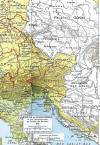 |
| 843 |
12th century manuscript records that Croatian monarchs were elected, in particular that if king died childless, his successor was elected by seven "bans…ban
of Croatia, ban of Bosnia, ban of Sclavonia, ban of Posige, ban of Podrame ~ military Commander of
Slavic and Roman (Greek)
militia (Tr. çete ~ band or troop, çetenïɣ ~ trooper), ban of Albania, ban of Sremi"
who
belonged to the families of "comites in comitatibus Croacie: Kacigi, Cucari, Suacigi, Cudomirigi,
Mogorouigi, Subigi Counts in the counties of Croatia, Kacigi, Cucari, Suacigi, Cudomirigi,
Mogorouigi, Subigi".
The same source names "Stephanus Cucar, Saruba Cudomirigi, Ourica…Mogorouig…Cacig…Caran
…Can…Slauaz…Cucar…Petrus Suacig" as the bans of Croatia between the reigns of "regis
Suetopelegi" (who has not yet otherwise been identified in Croatia) and "Suinimiri
king of Croatia". |
| 860 |
860-880
Allied forces of Khazars and Oguzes displace Besenyos because of threat to
their trading routs. Crossing Itil, they settled instead of Magyars, whom
they displaced, in the vicinity of Don and Kama |
| 870 |
In second half of 9 c. Kimaks began drifting westwards. They
occupied lands of Bechens (Besenyo, Badjinak, Patsinak), whose. nucleus
were tribes of
Kangar (i.e. Kangals, Kangly, Kungurs, Kangars, Kangüys, Kanjüys etc.) political union, in
formation of Bechen tribal
union participated, in addition to purely Türkic tribes, Sarmatian and
Finno-Ugrian tribes. Bechens lived by cattle breeding in a tribal society |
| 889 |
After
889 Besenyos break through Khazarian border guards and replace Magyars from Levedia |
| 889 |
889-893 Besenyos, displacing Magyars from Atil-Kuzü toward Carpathian mountains,
settle down on plains from Don to western Dniepr |
| 893 |
Besenyos stop their pusuit of Majars at Dniepr, winter near the mouth of the river Buh |
| 893 |
Catastrophically cold winter of 892-893 froze Itil and Don made it possible for Besenyos, whom
the Oguzes attacked, to flee across the frozen rivers into Atelkuzu, although
some of them were stuck east of Yaik river |
| 894 |
Besenyos allied with Bulgars start a second attack of Majar tribes forcing them to
leave Atilkiji for Transylvania and the Upper Tisza region |
| 895 |
Expansion of Hungary (Magyar) state is a threat to Pannonian Croatia, it requested
help from Tomislav Duke of Dalmatian Croatia who defeated Hungarians (Magyar). Tomislav shook off
Frankish suzerainty, in early 900s established a lasting border along Drava River, and annexed
remnants of Pannonian Croatia, territories of later kingdom of Croatia. Croat leaders: Voinomir,
leader of Pannonia and Slavonia Croatians, accepted Frankish overlordship in 790s, fought Avars
with Frankish campaigns. Franks placed Croatians of Pannonia under Marchesi of Friulia |
| 910 |
Main mass of the Türks who flooded Maverennahr in the 10th century were Kanlys: the mother of the
Horezmshah Turken-Hatun (Türken-Khatun) came from Kanly. |
| 913 |
Besenyos, once a part of confederation of W. Khaganate, were driven toward lower
Syr-Darya and Aral Sea by Karluk Türks. They were grazing their herds between
Yaik and Itil rivers |
| 913 |
North of Sea of Azov Besenyos occupied Levedia, taking it from Magyars, and then
drove them from area between Dnepr and Lower Danube - Atelkuzu (Itil-Kiji ?) |
| 915 |
Besenyos appear before Kiev for first time in force. Kiev Prince Ingvar (Igor) I the
Old signs peace treaty with them establishing a frontier between Don and
Dniestr (? In 915 Kiev was controlled by Olaf (Oleg I the Seer, 882-916 )?) |
| 920 |
Khazars fight with Burtas (Steppe Alans or As), Oguzes, Byzantines, Besenyos and Kara
Bolgars |
| 934 |
Besenyos join in Hungarian invasion of Byzantium. Thrace. |
| 944 |
Besenyos join in Kiev Prince Ingvar (Igor) I the Old raid on Byzantium |
| 948 |
Emperor K.Porphirogenesos (948-952)D’Administrando Imperio: Besenyos consist
of communities:
Ertim (or Erdem; the leader - Baicha, then - Yavdy),
Chor (the leader - Kyugel, then - Kuerchi),
Yula (the leader - Korkutkhan, then - Kabukschin),
Kukhey (the leader - Ipa, then - Sura),
Karabai (the leader - Karduxm),
Tolmach (the leader - Kortan, then - Boru),
Kapan (the leader - Yazy),
Choban (the leader - Batahan, then - Bula). |
| 948 |
Besenyo communities, three of which (Ertim, Chor and Yula) are ”Kangar”, meaning
“brave”, occupied banks of rivers running into Black Sea:
Choban (in Don area),
Tolmach (in area of Don flowing into the sea),
Kyulbey (Donets),
Chor (the east of Dnepr),
Karabai (between Dnepr and Bug),
Ertin (Dniestr),
Yula (Prut),
Kapan (lower Danube) |
| 948 |
First three Besenyo communities had contacts with Oguzes, Khazars, Alans, and
Crimea;
Yula bordered on “Türkey” (Hungary),
Kapan bordered with Danube Bolgars.
A part of names are Türkic title ranks (Yula, Chor, Kapan = Kapgan, Kul, Bey),
and names of leaders in most cases mean colors: Kuerchi = blue, Kakhushkin =
wood bark, Sulu = ash, Boru = grey, Yazy = swarty, Bula = multi-colored,
Yavdy = brilliant |
| 950 |
Al Mas'udi (died in 956) describes 4 Türkic peoples: Ydjni, Badjkurt (Maskurts,
Masguts, Herodotus (5-th c. BC), Strabo (c.64 BC - A.D. 20), and C. Plinius
Secundus (62-113 AD) Massagetae Scythians), Badjanak (Besenyos), Nukardi) |
| 960 |
Besenyos live in Moldova (10th c.-1171) |
| 964 |
Besenyos seriously threaten Khazaria |
| 965 |
Svyatoslav possibly signed agreement with Besenyos before crossing their territory. He allies
with Oguz (Russ. Torks/Uzes). Purpose to gain tribute from Viatchi on Oka by
removing their Khazar overlords. He also conquers Yasians and Kasogians in
Taman-Kuban area. |
| 965 |
Knyaz Svyatoslav of Kiev seizes Sarkel |
| 969 |
Besenyo Khan Kura captures Kiev |
| 972 |
8 Besenyo tribes, under Khan Kura, of Kipchak stock with Oguz element, freed of
Khazar dominance, defeat Russian prince Svyatoslav and make a drinking cup of
his scull. Besenyos continuous fights with Khazars, Byzantines and Rus |
| 993 |
Rus defeat Besenyos and found city Pereyaslavl (Russ. “Victory”) |
| 996 |
Besenyo attack Belogorod |
| 1025 |
Seljuk Beg of Kangar's Kynyk branch of Oguzes founded Seljuk Sultanate. Seljuk Beg's father held
high position, probably one of dynastic leaders of Kangars in Oguz Yabgu State, and gave his name both to state and dynasty. |
| 1026 |
Besenyo invasion of Byzantium is repulsed by Constantine Diogenes |
| 1130 |
In 12th century Kanly are mentioned on the
banks of r. Chu, when Türkic Karakhanid Khan asked Karakitais for a help against Kanly and Karlyk (aka Karluk),
which ended in Karakitais absorbing Karakhanids together with Karluks and local Kanly
Kangars |
| 1036 |
Yaroslav's victory over Besenyos |
| 1040 |
SELJUK SULTANATE
1037–1194 A.D
Founder – Tugrul Beg of Kangar stock
Area - 3.9 million km2 (1080) |
 |
| 1045 |
Byzantine-Besenyo agreement. Emperor Constantine IX Monomachus (1042-1055) accepts part of
Besenyos, led by Kegenes, to settle down in Dobruja, they received land and
three fortresses, as federates, against attacks of other Besenyo tribes, led
by Tyrach |
| 1045 |
Byzantines call Besenyos and Kumans “Skythicon“ |
| 1050 |
Biruni of Khwarezm: Language of Alans is a compound Khwaresmian and Besenyo-Türkish.
Besenyo language is Kipchak language. |
| 1050 |
Before 800, Alans or Asses lived, together with Besenyos, around lower reaches of
the Amu-Darya (Uzboy) flowing into Caspian Sea, and later, after river
changed its course, they migrated to coast of Sea of the Khazars |
| 1051 |
Besenyo invade Byzantium. |
| 1060 |
Kipchaks replace Besenyos from N Caucasus steppes. Stan of Kipchak Khans is located on
river Sunj. N Caucasus steppe is an important component of Deshti-Kipchak. |
| 1064 |
Besenyo invade Byzantium across Thrace to gates of Constantinople |
| 1065 |
600K Oguzes crossed Danube and devastated Balkans to Thessalonica. Emperor
Constantine X Ducas, and then Besenyos and Bolgars annihilated them. Remains
of Oguzes were subjugated, eliminated or assimilated by Kipchaks |
| 1071 |
Besenyo, in service of Byzantium, desert Emperor Romanus Diogenes V (1067-1071) in
favor of Sultan Alp Arslan. |
| 1087 |
Besenyo invade Byzantium across Thrace, are driven back, and defeat Alexius Comneus. |
| 1091 |
Kipchaks under Tugorkhan (?-1096) (Grousset's Togortak) and Bonyak (Grousset's Maniak)
are allied with Byzantium under Alexius Comnenus, and together crushed
Besenyo army at Mount Lebunion |
| 1040 |
HOREZM EMPIRE, a descendent of SELJUK SULTANATE
1194 - 1220 A.D
Founder – Anush Tigin Gharchai of Halach/Kalach stock, which ascends to ala,
alach, alacha, i.e. tribe Alachin, Chinese Boma
Area - 3.6 million km2 (1218) |
 |
| 1096 |
Per Rabbi Nissim, seventeen Khazarian communities join nomads (Besenyo, Bolgars,
Oguses) |
| 1117 |
Kipchaks under Khan Otrok retreat to N Caucasus steppes. Kipchak Khan Syrchan remains
in Don Steppes. Kipchaks under Khan Otrok on way to N Caucasus destroy
Sarkel. Its inhabitants with Besenyos and Oguz Türks migrate to Russian
principalities |
| 1121 |
Vladimir Monomakh defeats Berendeys, Oguzes (Torks), and Besenyos. The latter flee
from Rus |
| 1122 |
Kipchak Khan Bonyak defeats Besenyos at battle of Eski Zagra. Cumans subsequently
occupy their lands |
| 1123 |
Scyths/Besenyos were really wiped out by Byzantine Emperor John II in 1123 |
| 1171 |
Besenyos lose control of Moldova to Cumans (1171-1241) |
| 1220 |
Horezmshah's Kanly wife nephew Gair-Khan, head of Otrar fortress, was culpable
for Chingiskhan invasion. Main forces of Horezmshah against Chingiskhan consisted of Kanly. Gengiz Khan conquest of Bukhara, Samarkand, Tirmidh and Gurganj. Kangli garrisons slaughtered |
| 1230 |
Giovanni da Pian del Carpine passed through Chagatay Ulus north of Tian Shan in 1245:
from land of Kangittæ (Kangar) we entered (Pamir) country ruled by Soldan Alti, who was destroyed with all his progeny by Tatars (Mongols) with innumerable cities with castles ruined, and many towns left desolate. Chagatai Ulus created by 1261. |
 |
| 1237 |
Invasion of Asses and Kipchaks in N.W. Caspian and N. Caucasus. Leading Kipchak
warrior Bachman killed, Khan Kotyan retreat beyond Tanais. Batu starts
encircling maneuver going through Burtases, Erzya Moksha, and Rus |
| 1239 |
Assimilation of Alania into Ulus Juchi |
| 1250 |
In 13th century number of Besenyo communities grew to 13, and among names were
Aba, Balchar, Bator, Bychkyly, Eke, Ilbeg, Kure, Karaja, Temir, Teber, Sol.
Besenyo fortresses are named: Salma, Saga, Kerbak. These words confirm
that Besenyo language was Türkic Kipchak dialect |
| 1390 |
At the end of the 14 century eastern Kanlys lived between Seyhun (Syr-Darya) and Talas,
in Djochy (aka Djuchi, Juchi) ulus. |
| 1610 |
In the beginning of 17th century the allodial Kirgiz Khan Tursun ruled Kanlys and Katagans,
they
lived in Tashkent district. |
 ,
I ,
,
I ,

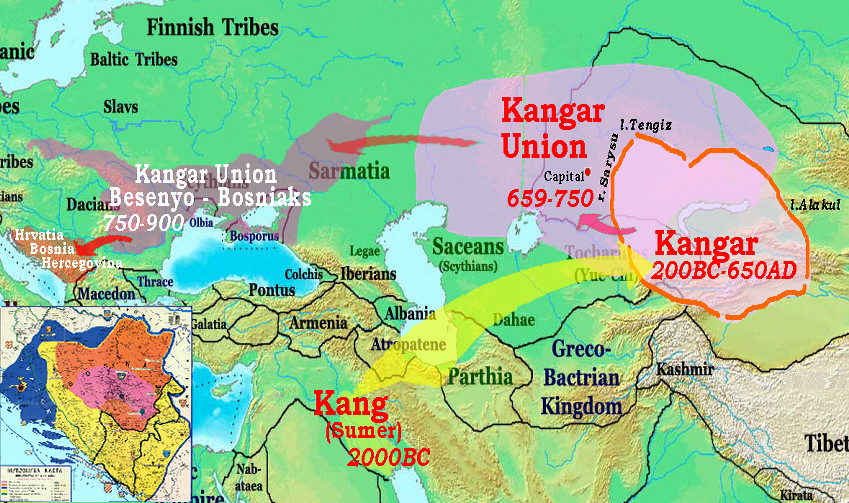
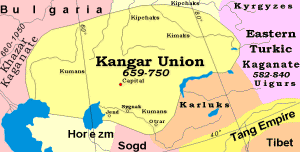
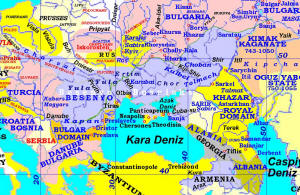
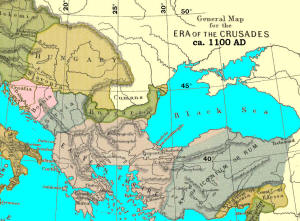
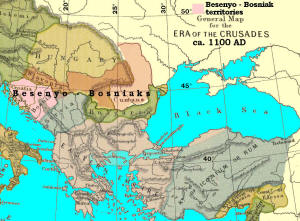







 , supposedly were
“Dunghu“
Mongolian people incorporated in the 3rd c. BC by the Eastern Hun's Shanyu Mode into the
Eastern Hun's state. The Kai tribe, which by the 650 AD was associated with the Ogur
Türkic Huns and their Türkic descendents for 850 years, apparently was completely
Turkified by the time when they became a dynastic tribe of the Kimak Kaganate..
, supposedly were
“Dunghu“
Mongolian people incorporated in the 3rd c. BC by the Eastern Hun's Shanyu Mode into the
Eastern Hun's state. The Kai tribe, which by the 650 AD was associated with the Ogur
Türkic Huns and their Türkic descendents for 850 years, apparently was completely
Turkified by the time when they became a dynastic tribe of the Kimak Kaganate..




